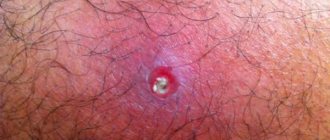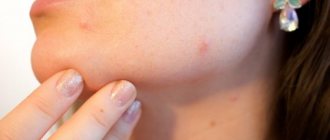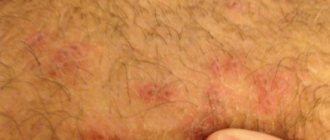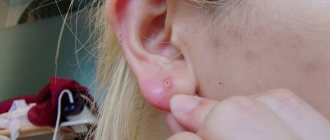The intimate area is extremely sensitive to the effects of any infectious factors. This is due to the structural features of the skin and organs located in the groin area.
If acne appears in the intimate area , there is a strong desire to get rid of them as quickly as possible.
But the causes of such rashes are not always safe; they can even have serious consequences for a person’s life.
Causes of purulent pimples in the intimate area in men and women
There are many different reasons for the occurrence of purulent acne in the intimate female and male area. There are several main predisposing factors for the occurrence of abscesses:
- Bacterial infection. Most often, neoplasms in the intimate area arise as a result of the activity of a bacterial pathogen - staphylococcus. When it gets on the skin and deep into the tissues, the bacterium occupies the perifollicular space, causing the appearance of a boil. First, a small compaction appears, which over time transforms into a subcutaneous abscess with a head. As the pimple matures, the tissues around this area become inflamed, acquire a red or purple tint, and a glossy sheen. It is difficult for a person to move; even touching underwear brings pain. The reason for the introduction of staphylococcus is shaving without antiseptic treatment or neglect of hygiene procedures.
- Viral infection. One of the diseases that provokes acne in the intimate female area can be herpes. The virus differs from the usual lip fever in type. Infection occurs from a potential carrier of the virus through direct or household contact. A lot of small rashes appear on the skin, prone to merging. The skin is painful and swollen. In women, the area from the perineum to the anus (sometimes the buttocks) is affected. A purulent pimple in men in the intimate area is most often located on the head of the penis.
- Allergic reaction. Sometimes it manifests itself as rashes on the skin of the body and in intimate female areas. The reason for this reaction is the use of certain drugs. The detergent used for underwear can provoke an allergic reaction. In addition to acne, swelling, itching, and redness are observed on the skin and mucous membranes.
- Neoplasms. Internal formations can also provoke the appearance of a purulent intimate pimple in women. These include atheroma (accumulation of sebaceous secretions), bartholinitis (inflammation of the Bartholin gland), lipoma (fatty tumor). These cysts in the genital area are benign and do not pose a clear threat to health. They cause discomfort, and in the early stages they look similar to regular acne. The labia majora in women and the groin area are affected.
- STD. Sexually transmitted diseases often cause various rashes on the tissues of the intimate sensitive area in men or women. With syphilis, chancre appears on the genitals - ulcers and erosions characteristic of this disease. A rash is observed on the labia in women, on the penis and its head in men.
Provoking factors for most diseases are weakened immunity (colds, stress, alcohol intake), poor personal hygiene, hormonal disorders, shaving or deep depilation of the bikini area in violation of sanitary standards and unprotected sex life.
Differential diagnosis of acne in the perineum
Which doctor should I consult if acne appears in the perineum?
If these symptoms develop in the genital area, you must make an appointment with a venereologist/dermatovenerologist. An important step in making an accurate diagnosis is differential diagnosis.
What tests need to be taken if acne appears in the perineum?
After collecting an anamnesis and in-person examination of the patient, the doctor determines the types of tests to be performed. First of all, laboratory testing for STDs is prescribed: bacteriological culture, PCR, ELISA.
For women, a smear is taken from the cervical canal, for men from the urethra. It is also important to rule out early onset or progression of diabetes. If the doctor identifies acne in the perineum in a patient with an increased risk of diabetes, the patient is prescribed blood tests for sugar and glycated hemoglobin.
If a negative result is obtained and it is confirmed that the patient does not have sexually transmitted pathologies, a hemotest is prescribed. Often, pimples in the perineum act as an allergic reaction. Therefore, you may need to take a blood test for allergies.
In women, the cause of the appearance of such a symptom as acne in the perineum can be thrush - a culture for candidiasis will be required.
Dangerous symptoms and when a formation can develop into an abscess of the groin area
The most dangerous symptoms that accompany the appearance of large purulent pimples in the intimate female area include signs of sexually transmitted diseases. If there is a suspicion of such diseases, you should undergo a full examination for STDs, including syphilis.
Adverse symptoms indicating the development of an acute process and acne include:
- severe incessant pain in the intimate inflamed area;
- presence of vaginal discharge;
- presence of a strong foul odor;
- menstrual irregularities due to pimple;
- difficulty urinating;
- increased temperature of the intimate problem area and body;
- signs of general malaise (weakness, apathy, drowsiness).
The cause of abscesses in the groin area is clogged sebaceous glands that do not have a channel for the outflow of contents or boils that do not break through for a long time.
You can suspect a similar phenomenon by paying attention to the size of the lump and its appearance. Cysts or purulent subcutaneous pimples, prone to degeneration into an intimate abscess, are distinguished by pain, dense structure, and increase in size.
Pimples in the perineum with phthiriasis
Another sexually transmitted disease that is accompanied by a rash. Can be transmitted without direct sexual contact.
The causative agent is the ectoparasitic insect Phthirus pubis. When diagnosing phthiriasis, the patient is prescribed laboratory tests for STDs. Since the chance of simultaneously having a sexually transmitted disease reaches 40%.
Phthiriasis is accompanied by less severe itching than pediculosis.
It is characterized by the development of rashes in the form of red spots with a diameter of about 5 mm.
The main therapy for phthiriasis is the use of drugs containing pyrethrin, a natural insecticide.
Which doctor should I contact and methods of treating ulcers on the genitals
Purulent, inflamed pimples in the intimate female area require prompt consultation with a doctor. Such formations bring significant discomfort, disrupt normal life processes, and cause complexes. Most diseases that cause ulcers are contagious and are easily transmitted through sexual contact and household contact.
If purulent, painful pimples are detected in the vagina or groin area, a woman can consult a gynecologist or dermatologist. If necessary, further treatment is carried out by a venereologist or surgeon.
Medication
The type of drug treatment for the bikini area depends on what caused the appearance of multiple purulent pimples in the area of a woman’s intimate organs.
For bacterial infections, the patient undergoes a course of antibiotic therapy. This allows you to stop the proliferation of dangerous microorganisms and reduce the external manifestation of the disease on the genitals.
Antibiotics are taken orally or applied to the intimate area. For external treatment of the area, Levomekol ointment is used, which has a pronounced effect on pathogenic flora, accelerating the wound healing process. Ceftriaxone, Fusidine sodium, Mupirocin are prescribed.
Herpetic lesions of the intimate area in a man or woman require the use of antiherpetic antiviral drugs. The medicine helps reduce the manifestation of the disease, relieve itching, irritation, and swelling of the tissues near a purulent pimple. The most common drug for treating this disease is Acyclovir, which is taken orally and applied to the affected intimate areas.
Need advice from an experienced doctor?
Get a doctor's consultation online. Ask your question right now.
Ask a free question
It is relevant to use antihistamines for allergic manifestations in the genital area, drugs to normalize hormonal levels, immunostimulants, vitamin complexes, and antiviral medications.
Sometimes it is necessary to use antiseptics to treat purulent, inflamed pimples on a woman’s intimate inflamed area. Use a solution of hydrogen peroxide, potassium permanganate, alcohol, Furacilin, Chlorhexidine.
Surgical
Radical procedures are carried out when a tumor in a woman’s intimate area cannot disappear under the influence of drug therapy. The indication for surgery is a purulent, painful pimple (boil) that is unable to break out on its own, inflammation of the Bartholin gland, atheroma, lipoma (wen), abscess of the intimate organs.
Depending on the type of tumor and its location, the doctor selects the current technology for the operation. Purulent boils and abscesses in the bikini area are opened with extreme caution so that the contents of the pimple capsule do not spread to healthy areas of the skin, causing a complex pathological process.
Intimate atheromas are removed due to pain and the likelihood of suppuration of the contents. Lipomas are prone to uncontrolled growth. A tumor in this area is disposed of before it has time to grow, disrupting the normal functioning of the body.
Removal of a Bartholin gland cyst is carried out if drug therapy does not give the desired result or cases of relapse of the disease are frequent.
Turning to surgery when multiple purulent pimples appear in the intimate female area is a rare occurrence. Minor lesions can be managed with conservative treatment. Do not be afraid to consult a doctor in a timely manner.
Home methods
Treatment with folk or home methods is possible only for mild cases of the disease, with prior agreement with the doctor.
If a woman notices one or several large purulent pimples in the intimate organs area, they can be treated with a decoction of chamomile, calendula or yarrow.
These plants have a good antiseptic effect and help cope with unpleasant sensations. Aloe and plant juice are suitable for combating.
Small purulent pimples localized in intimate sensitive areas can be treated with salicylic ointment. Vishnevsky ointment and Levomekol are suitable for use. You can speed up the process of maturation of a large abscess and force the contents to come out with ichthyol ointment.
Causes of acne not related to illness
Why do pustules and pimples appear on the genitals if a person is completely healthy?
Such formations can occur due to the following disorders :
- Failure to comply with personal hygiene rules.
- Wearing synthetic, tight underwear.
- Hypothermia or overheating of the body.
- Consequences of mechanical injuries after removing pubic hair with a razor, wax, cream, sugar paste.
- Poor nutrition (abuse of fatty, sweet, spicy foods).
- Stress.
- Hormonal changes in the body (puberty, pregnancy, childbirth, menopause).
- Consequences of an allergic reaction of the body to soap, powder, etc.
Measures to prevent purulent rashes on the genitals
To protect yourself from the occurrence of pimples with pus in a woman’s intimate painful area, you should follow simple rules:
- observe hygienic care of intimate places;
- do not squeeze out a single pimple with pus;
- give preference to natural cotton underwear;
- use personal hygiene items;
- after hair depilation of the bikini area, carry out antiseptic treatment of the intimate area;
- avoid casual sexual relations without the use of contraceptives;
- promptly treat infectious diseases of the genitals;
- give up bad habits if acne with pus occurs;
- eat well;
- avoid stressful situations;
- monitor the state of the immune system.
Such preventive measures cannot guarantee a woman complete protection from the risk of multiple purulent pimples on intimate sensitive areas, but they significantly reduce the likelihood of their formation.
An abscess on the genitals is a physical and aesthetic problem that requires timely examination. You should not try to treat an abscess in the groin in women on your own until the true cause of the ailment is discovered. It is better to trust experienced specialists and get topical acne treatment without the risk of complications for the intimate sensitive area.
The article has been reviewed by the site editors











